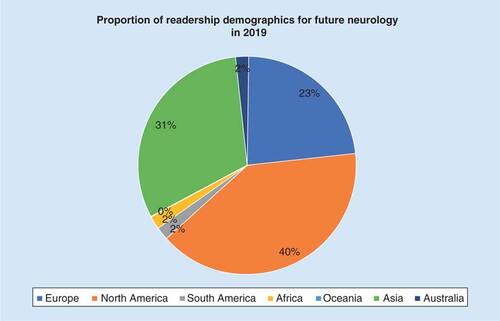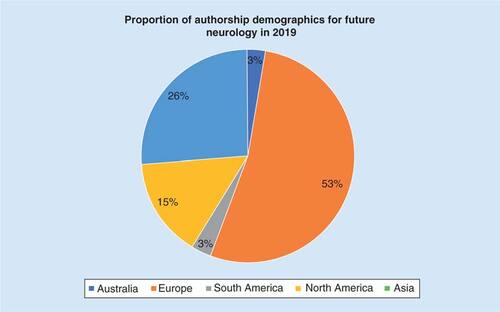Abstract
To all our readers, we are delighted to welcome you to the fifteenth volume of Future Neurology. We are also excited to welcome you to the second Open Access issue of the journal. Since the launch of this title, we have continued to publish high-quality scientific research and commentary, and the open access model will allow us to share our great content with an even bigger audience. 2019 was another exciting year for Future Neurology with the continued publication of timely, high quality manuscripts. We are proud to present some of our content highlights within this article. We would also like to take this opportunity to thank all of our valued Editorial Board members, readers and contributors for their continued support. As we move into 2020, we very much look forward to seeing the journals continuous progression and development.
Content highlights of 2019
At the time of writing (December 2019), our most read article was a Review article entitled ‘Therapeutic targets for malignant peripheral nerve sheath tumors’ [Citation1]. The paper was authored by Lai Man Natalie Wu and Qing Richard Lu from Cincinnati Children’s Hospital Medical Center (OH, USA), who discuss existing therapies and targeted chemotherapeutic options being tested clinically and potential therapeutic avenues identified in preclinical studies for malignant peripheral nerve sheath tumors.
Another one of our most popular articles was the Special Report ‘Cerebrospinal fluid biomarkers in neurodegenerative disorders’, which describes the application and state of development of a range of cerebrospinal fluid biomarkers in common neurodegenerative disorders including Alzheimer’s disease, frontotemporal dementia and prion diseases [Citation2].
Also highly read was a Commentary by Theresa SP Rothenbücher & Alberto Martínez-Serrano that overviewed cerebral organoids and 3D aggregated cell cultures as well as examples of neurological diseases, where organoids aid in understanding disease etiology and design therapies [Citation3].
Another highly read Research article by Jamil Ahsan Kazi & Rasdi Zatilfarihiah from Universiti Teknologi MARA (Selangor, Malaysia), discovered that gabapentin neutralized the morphine sensitization in a rat hypothalamus [Citation4].
Readership demographics
It is great to see that in 2019, our journal is being read throughout the world, with the highest number of readers being from the North America (40%), Asia (31%) and Europe (23%) ().
Authorship demographics
It is interesting to see where the journal is receiving its content from; in 2019, authors from Europe submitted the highest volume of content (53%), followed by Asia (26%) (). In terms of country, the highest numbers of submissions were by the United Kingdom of Great Britain and Northern Ireland. We continue to receive high-quality content from across the globe, including an emerging authorship in Australia and South America.
Social media
Future Neurology continues to be active across social media including on our LinkedIn Future Science Neurology Group [Citation5] and Twitter, @fsgfnl [Citation6]. Our regular posts include journal highlights such as newly published content and the latest neurology news. This year, we have thoroughly enjoyed engaging with professionals across the field and we welcome readers to connect with us on various forms of social media going into 2020.
Conclusion
We appreciate all feedback from the neurology community regarding the direction of our content such as ‘hot topics’ in the field and trends that you feel should be covered in Future Neurology. We welcome unsolicited article proposals and would be delighted to hear from you. In particular, we encourage submissions on novel and translational work such as:
Understanding biological processes within the nervous system.
Mechanisms and pathologies of disease, injury and disorder including neuropsychiatry.
Disease modeling systems utilizing computer, in vitro and animal approaches.
Genetic factors and precision medicine.
Diagnostic and prognostic advances in screening, biomarker and imaging approaches, in addition to their application in the clinic.
Disease risk assessment and epidemiological studies.
Improving current management and treatment approaches.
Identification of novel therapeutic targets and drug delivery systems.
Drug development, clinical testing and safety.
Novel and emerging therapeutics including cell therapy, gene therapy, nanomedicine, immunotherapy and bioelectronics.
Real-world evidence and outcomes research.
We greatly look forward to collaborating with you all over the next year and hope Future Neurology continues to fulfill its role in the medical community and grow and develop as a journal.
Financial & competing interests’ disclosure
K Lovesey is an employee of Future Medicine Ltd. The author has no other relevant affiliations or financial involvement with any organization or entity with a financial interest in or financial conflict with the subject matter or materials discussed in the manuscript apart from those disclosed.
No writing assistance was utilized in the production of this manuscript.
Additional information
Funding
References
- LaiMan NW, QingRL. Therapeutic targets for malignant peripheral nerve sheath tumors. Future Neurol.14(1), 1–12 (2019). https://www.tandfonline.com/doi/10.2217/fnl-2018-0026
- RobeyTT, PanegyresPK. Cerebrospinal fluid biomarkers in neurodegenerative disorders. Future Neurol.14(1), 1–10 (2019). https://www.tandfonline.com/doi/10.2217/fnl-2018-0029
- RothenbücherTSP, Martínez-SerranoA. Human cerebral organoids and neural 3D tissues in basic research, and their application to study neurological diseases. Future Neurol.14(1), 1–6 (2019). https://www.tandfonline.com/doi/10.2217/fnl-2018-0043
- KaziJA, ZatilfarihiahR. Gabapentin completely neutralized the acute morphine activation in the rat hypothalamus: a c-Fos study. Future Neurol.14(2), 1–10 (2019). https://www.tandfonline.com/doi/10.2217/fnl-2018-0037
- Future Neurology LinkedIn (2019). www.linkedin.com/groups/8204606/
- Future Neurology (@fsgfnl) on Twitter (2019). https://twitter.com/fsgfnl


